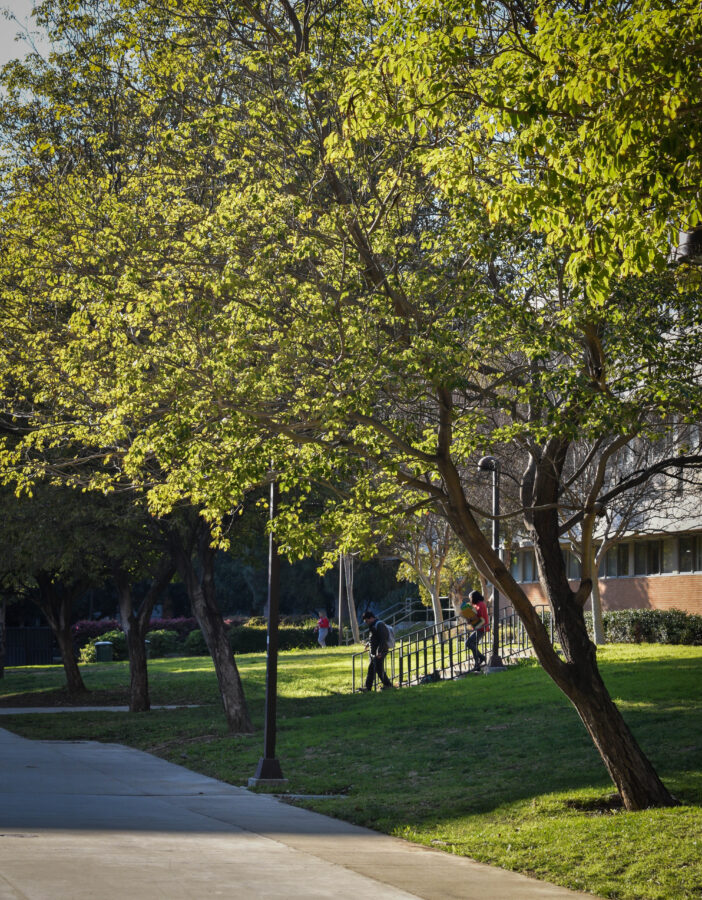Opinion: Global warming in your backyard?
The outside of Sierra Hall on March 2, 2023.
May 8, 2023
Steve Graves is a professor in the geography and environmental studies department at the College of Social and Behavioral Sciences. You can learn more about him here.
Global warming, which is more accurately known as “climate change,” isn’t just something that affects island countries and polar bears. Abundant changes are evident here at CSUN. Consider the jacaranda trees that bloom each spring. For years, jacarandas were known as “final exam trees” because they bloomed just before finals week. In recent years though, the jacarandas are more likely to shower their purple petals onto sidewalks around spring break. This has been true for around the last 20 years here because summer comes earlier now to the San Fernando Valley, and it’s sure to come even earlier in the next decades. Without significant changes in our diets, energy systems, and lifestyles, the Valley will surely become a very different type of place.
Climate change, rather than simply “global warming” is a better description of what is happening because our weather patterns will become far less predictable than they have been. In just the last year, California has experienced record rainfall, record heat, and intense drought, and as I type this, the weather service is announcing a blizzard warning for Southern California – the first in many decades. So, expect the unexpected, but you should mainly expect the Valley to be hotter, drier and smokier in the coming years.
Expect record heat and record electricity bills. We’re going to have to get used to heat waves that are earlier, later, longer and hotter. Just last year, temperatures exceeded 120 degrees in Woodland Hills. That was an all-time high; the kind of dangerous heat found only in the tropics or equatorial zones. If you look at a list of all-time high temperatures by date or month for the Valley – almost all are recent. This trend is even more pronounced when you examine the “overnight lows” – which means that our hot days will be accompanied by nights that never cool off, requiring your air conditioning system to run all day and all night.
Most of the Valley’s record low temperatures, on the other hand, are many decades old, and while that’s welcome news for many of us who hate cold weather during the winter, it’s unwelcome to those who cherish those glorious weeks with “nice weather.” We won’t see those weeks as often in May, June, September and October. The heat will be more unrelenting. Hundred-degree days are already far more common than they were in the 1980s and it’s likely that July and August will be dominated by days over 95 degrees.
You’ll want to jump in the pool, but that too may become an issue because drought is the other major consequence of climate change facing the Valley. Two of the worst droughts Californians have ever experienced have occurred in the last 10 years or so. These droughts have made our water supply precarious and it’s likely to get worse. Green grass lawns will disappear, which is a bonus if you hate mowing, but xeriscaping will probably make it even hotter. Long showers will likely not go away, but they’ll be more expensive as water providers try to discourage wasteful water use. Expect that your tap water will be ‘recycled’ – going from toilet to tap and back again many times over. Sounds gross? Sure does, but bottled water is already part of the problem, so expect to ditch the plastic in coming years too as governments try to eliminate sources of climate change. The cost of water-thirsty crops and animal feed is likely to increase – and that will probably mean your grocery bill will trend upward as well. Maybe the adoption of more drought-tolerant crops will cause a slow change in our dietary practice and we’ll adopt a more Mediterranean-style diet.
Expect to stay in the house more. But at least you’ll be out of the heat. Your lungs will probably thank you because the air quality is likely to be worse. Hopefully, the widespread adoption of electric cars will help. That would reduce the exhaust from cars, which contributes to climate change, and react at ground level with sunlight and heat to create a variety of air pollutants that harm your lungs and irritate your eyes. What gains we make by adopting e-cars may be offset by increased wildfires though – because our forests will be ravaged by drought and ignited during more intense and more frequent wind events.
It all sounds horrible and it might be. But like so many crises that we have faced over the years, I maintain a belief that we will face them, and find ways to cope with our ever-evolving “new reality.” I maintain this faith because I interact every day with students who are bright, energetic and creative – who regularly treat problems that seemed intractable to my generation as mere potholes on the road to a different future.
